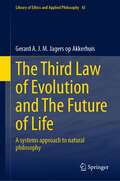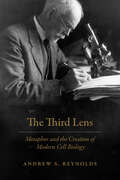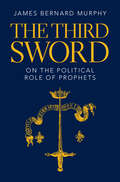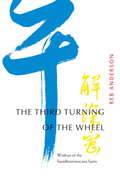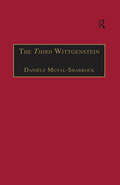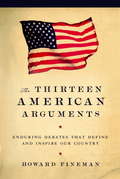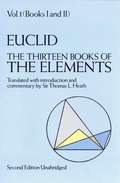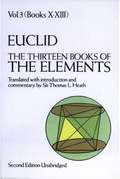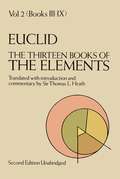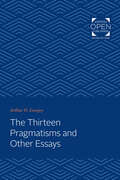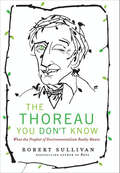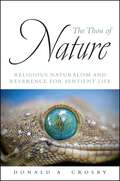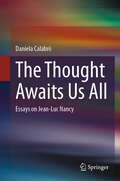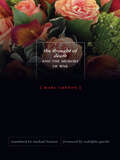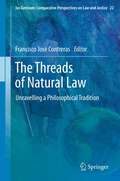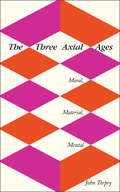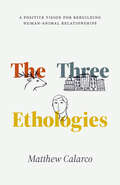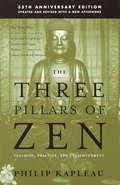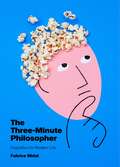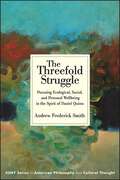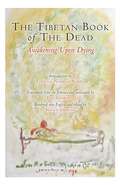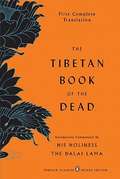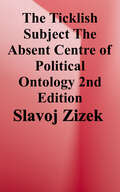- Table View
- List View
The Third Law of Evolution and The Future of Life: A systems approach to natural philosophy (Library of Ethics and Applied Philosophy #43)
by Gerard A. Jagers op AkkerhuisThis book offers a step-by-step introduction to an integrated theory of physical and biological evolution, from the early universe to the world we know today. To this end, the well-known laws of variation and selection are supplemented by a third law. This law describes the increase in complexity based on the transitions from quarks to hadrons, to atoms, to molecules, to bacteria, to eukaryotic cells, and so on. These insights revolutionize existing theoretical frameworks for analyzing organization in nature, accelerating developments in natural philosophy. In this way, the author develops a basic framework for thinking about evolution, which can be applied to current debates in various research fields. For example, the new approach finally helps to find the systems-based definitions of organism and life that have been sought for so long. By extrapolating the framework one can even hypothesize about future evolution and our place as humans in it. An exciting read for both philosophers and scientists.
The Third Lens: Metaphor and the Creation of Modern Cell Biology
by Andrew S. ReynoldsDoes science aim at providing an account of the world that is literally true or objectively true? Understanding the difference requires paying close attention to metaphor and its role in science. In The Third Lens, Andrew S. Reynolds argues that metaphors, like microscopes and other instruments, are a vital tool in the construction of scientific knowledge and explanations of how the world works. More than just rhetorical devices for conveying difficult ideas, metaphors provide the conceptual means with which scientists interpret and intervene in the world. Reynolds here investigates the role of metaphors in the creation of scientific concepts, theories, and explanations, using cell theory as his primary case study. He explores the history of key metaphors that have informed the field and the experimental, philosophical, and social circumstances under which they have emerged, risen in popularity, and in some cases faded from view. How we think of cells—as chambers, organisms, or even machines—makes a difference to scientific practice. Consequently, an accurate picture of how scientific knowledge is made requires us to understand how the metaphors scientists use—and the social values that often surreptitiously accompany them—influence our understanding of the world, and, ultimately, of ourselves. The influence of metaphor isn’t limited to how we think about cells or proteins: in some cases they can even lead to real material change in the very nature of the thing in question, as scientists use technology to alter the reality to fit the metaphor. Drawing out the implications of science’s reliance upon metaphor, The Third Lens will be of interest to anyone working in the areas of history and philosophy of science, science studies, cell and molecular biology, science education and communication, and metaphor in general.
The Third Turning of the Wheel
by Reb Anderson James William ColemanIn his previous book, Being Upright: Zen Meditation and the Bodhisattva Precepts, Reb Anderson Roshi described how we must become thoroughly grounded in conventional truth through the practice of compassion before we can receive the teachings of the ultimate truth. In The Third Turning of the Wheel, he introduces us to the next stage of our journey by invoking the wisdom of the Samdhinirmocana Sutra.According to Anderson, the main purpose behind this enigmatic sutra is to reconcile the apparent contradictions between the original teachings of the historical Buddha and the later teachings of Mahayana Buddhism. Anderson reflects on the great metaphysical questions proposed in the Samdhinirmocana Sutra-the nature of ultimate reality, the structure of human consciousness, the characteristics of phenomena, the stages of meditation, and the essential qualities of a buddha-with the clarity of a scholar and the insight of a practitioner.
The Third Wittgenstein: The Post-Investigations Works (Ashgate Wittgensteinian Studies)
by Danièle Moyal-SharrockThis anthology establishes the existence of a distinct and important post-Investigations Wittgenstein, uncovering the overlooked treasures of the final corpus and crystallising key perceptions of what his last thought was achieving. Speaking of a 'third Wittgenstein', this book seeks to correct the traditional bipartite conception of Wittgenstein's thought into his Tractatus and Philosophical Investigations by focusing on his neglected last masterpiece, On Certainty, and works contemporaneous with it: Remarks on Colour, Last Writings in the Philosophy of Psychology, and Remarks on the Philosophy of Psychology. Â Leading international Wittgenstein scholars reveal why On Certainty should be recognised as one of Wittgenstein's three great works. This sustained examination shows that the third Wittgenstein breaks new ground with insights unprecedented in both his own work and philosophy more broadly, giving us keys to the solution and dissolution of problems that have plagued philosophy since Descartes, such as philosophical scepticism and the mind-body problem. Wittgenstein's ultimate and revised positions with regard to epistemology, foundationalism, 'grammar', naturalism, the psychology of language, and psychological indeterminacy are clearly delineated. This book also provides new and illuminating accounts of difficult concepts, such as patterns of life, experiencing meaning, meaning blindness, lying and pretence.
The Thirteen American Arguments
by Howard FinemanHoward Fineman, one of our most trusted political journalists, shows that every debate, from our nation’s founding to the present day, is rooted in one of thirteen arguments that–thankfully–defy resolution. It is the very process of never-ending argument, Fineman explains, that defines us, inspires us, and keeps us free. At a time when most public disagreement seems shrill and meaningless, Fineman makes a cogent case for nurturing the real American dialogue. The Thirteen American Argumentsruns the gamut, including •Who Is a Person?The Declaration of Independence says “everyone,” but it took a Civil War, the Civil Rights Act, and other movements to make that a reality. Now, what about human embryos and prisoners in Guantanamo? •The Role of FaithNo country is more legally secular yet more avowedly prayerful. From Thomas Jefferson to James Dobson, the issue persists: Where does God fit in government? •America in the WorldIn Iraq and everywhere else, we ask ourselves whether we must change the world in order to survive and honor our values–or whether the best way to do both is to deal with the world as it is. Whether it’s the nomination of judges or the limits of free speech, presidential power or public debt, the issues that galvanized the Founding Fathers should still inspire our leaders, thinkers, and fellow citizens. If we cease to argue about these things, we cease to be. “Argument is strength, not weakness,” says Fineman. “As long as we argue, there is hope, and as long as there is hope, we will argue. ”
The Thirteen Books of the Elements (Dover Books on Mathematics #1)
by EuclidThis is the definitive edition of one of the very greatest classics of all time — the full Euclid, not an abridgement. Using the text established by Heiberg, Sir Thomas Heath encompasses almost 2,500 years of mathematical and historical study upon Euclid.This unabridged republication of the original enlarged edition contains the complete English text of all 13 books of the Elements, plus a critical apparatus that analyzes each definition, postulate, and proposition in great detail. It covers textual and linguistic matters; mathematical analyses of Euclid’s ideas; classical, medieval, Renaissance, modern commentators; refutations, supports, extrapolations, reinterpretations, and historical notes, all given with extensive quotes.“The textbook that shall really replace Euclid has not yet been written and probably never will be.” — Encyclopaedia Britannica.Volume 1. 151-page Introduction: life and other works of Euclid; Greek and Islamic commentators; surviving mss., scholia, translations; bases of Euclid’s thought. Books I and II of the Elements, straight lines, angles, intersection of lines, triangles, parallelograms, etc.
The Thirteen Books of the Elements, Vol. 3 (Dover Books on Mathematics #3)
by EuclidThis is the definitive edition of one of the very greatest classics of all time—the full Euclid, not an abridgement. Utilizing the text established by Heiberg, Sir Thomas Heath encompasses almost 2500 years of mathematical and historical study upon Euclid.This unabridged republication of the original enlarged edition contains the complete English text of all 13 books of the Elements, plus a critical apparatus which analyzes each definition, postulate, and proposition in great detail. It covers textual and linguistic matters; mathematical anayses of Euclid's ideas; classical, medieval, Renaissance, modern commentators; refutations, supports, extrapolations, reinterpretations, and historical notes, all given with extensive quotes.
The Thirteen Books of the Elements: Books Iii-ix (classic Reprint) (Dover Books on Mathematics #2)
by EuclidThis is the definitive edition of one of the very greatest classics of all time — the full Euclid, not an abridgement. Using the text established by Heiberg, Sir Thomas Heath encompasses almost 2,500 years of mathematical and historical study upon Euclid.This unabridged republication of the original enlarged edition contains the complete English text of all 13 books of the Elements, plus a critical apparatus that analyzes each definition, postulate, and proposition in great detail. It covers textual and linguistic matters; mathematical analyses of Euclid’s ideas; classical, medieval, Renaissance, modern commentators; refutations, supports, extrapolations, reinterpretations, and historical notes, all given with extensive quotes. Volume 1. 151-page Introduction: life and other works of Euclid; Greek and Islamic commentators; surviving mss., scholia, translations; bases of Euclid’s thought. Books I and II of the Elements, straight lines, angles, intersection of lines, triangles, parallelograms, etc.Volume 2. Books III-IX: Circles, tangents, segments, figures described around and within circles, rations, proportions, magnitudes, polygons, prime numbers, products, plane and solid numbers, series of rations, etc.Volume 3. Books X to XIII: planes, solid angles, etc.; method of exhaustion in similar polygons within circles, pyramids, cones, cylinders, spheres, etc. Appendix: Books XIV, XV, sometimes ascribed to Euclid.
The Thirteen Pragmatisms and Other Essays
by Arthur O. LovejoyOriginally published in 1963. The essays in this volume are critical and, with one exception, directed against the philosophic movement of pragmatism. "The Thirteen Pragmatisms" is an exercise in logical analysis and is a challenge to a group of philosophers who have taken on a collective name to show how their apparent diversities are to be reconciled. Few philosophers would call themselves orthodox followers of this train of thought, so these essays can be studied without a sense of personal injury that deadens the critical faculty and obscures insight. In The Thirteen Pragmatisms and Other Essays, logical technique is on display: the author's keenness in spotting double meanings and his ability to rephrase them in univalent form. This collection of essays should afford students of philosophy a set of cases in which they need not take sides but which give them an analytical method they can practice themselves on contemporary issues. The fact that these essays are on the whole critical gives them a heuristic value that dogmatic or expository essays would not have.
The Thoreau You Don't Know: What the Prophet of Environmentalism Really Meant
by Robert "Sully" SullivanRobert Sullivan, the New York Times bestselling author of Rats and Cross Country, delivers a revolutionary reconsideration of Henry David Thoreau for modern readers of the seminal transcendentalist. Dispelling common notions of Thoreau as a lonely eccentric cloistered at Walden Pond, Sullivan (whom the New York Times Book Review calls “an urban Thoreau”) paints a dynamic picture of Thoreau as the naturalist who founded our American ideal of “the Great Outdoors;” the rugged individual who honed friendships with Ralph Waldo Emerson and other writers; and the political activist who inspired Martin Luther King, Jr., Mahatma Gandhi, and other influential leaders of progressive change. You know Thoreau is one of America’s legendary writers…but the Thoreau you don’t know may be one of America’s greatest heroes.
The Thou of Nature: Religious Naturalism and Reverence for Sentient Life
by Donald A. CrosbyHumans share the earth with nonhuman animals who are also capable of conscious experience and awareness. Arguing that we should develop an I-thou, not an I-it, relationship with other sentient beings, Donald A. Crosby adds a new perspective to the current debates on human/animal relations and animal rights—that of religious naturalism. Religion of Nature holds that the natural world is the only world and that there is no supernatural animus or law behind it. From this vantage point, our fellow thous are entitled to more than merely moral treatment: protection and enhancement of their continuing well-being deserves to be a central focus of religious reverence, care, and commitment as well. A set of presumptive natural rights for nonhuman animals is proposed and conflicts in applying these rights are acknowledged and considered. A wide range of situations involving humans and nonhuman animals are discussed, including hunting and fishing; eating and wearing; circuses, rodeos, zoos, and aquariums; scientific experimentation; and the threats of human technology and population growth.
The Thought Awaits Us All: Essays on Jean-Luc Nancy
by Daniela CalabròThis volume shows how Nancy was able ‘to deconstruct’ the founding sign of all metaphysics and all transcendence by redefining the concepts of existence, corporeality, and community, opening them up to the ‘disclosure’ of the outside, to the ‘exception’ of the world. It draws on the work of the Italian philosopher, Roberto Esposito and includes a dialogue between Nancy and Esposito. The overcoming of the modern perspective is covered by Descartes and Hegel, who are analyzed in light of Nancy. This text proposes a deconstruction of the Western tradition in its philosophical, aesthetic, and political registers and conveys a new ontology that breaks with the categories of the One and the Multiple, the Universal and the Particular, in order to identify the relationship between the plural and the singular and understand what it means to be together, to be in common, to be in the world. It is suitable for scholars, researchers, and students of philosophy and comparative literature.
The Thought of Death and the Memory of War
by Marc CréponWar lays bare death and our relation to it. And in the wars—or more precisely the memories of war—of the twentieth century, images of the deaths of countless faceless or nameless others eclipse the singularity of each victim&’s death as well as the end of the world as such that each death signifies. Marc Crépon&’s The Thought of Death and the Memory of War is a call to resist such images in which death is no longer actual death since it happens to anonymous others, and to seek instead a world in which mourning the other whose mortality we always already share points us toward a cosmopolitics. Crépon pursues this path toward a cosmopolitics of mourning through readings of works by Freud, Heidegger, Sartre, Patocka, Levinas, Derrida, and Ricœur, and others. The movement among these writers, Crépon shows, marks a way through—and against—twentieth-century interpretation to argue that no war, genocide, or neglect of people is possible without suspending how one relates to the death of another human being.A history of a critical strain in contemporary thought, this book is, as Rodolphe Gasché says in the Foreword, &“a profound meditation on what constitutes evil and a rigorous and illuminating reflection on death, community, and world.&” The translation of this work received financial support from the French Ministry of Foreign Affairs.
The Threads of Natural Law
by Francisco José ContrerasThe notion of "natural law" has repeatedly furnished human beings with a shared grammar in times of moral and cultural crisis. Stoic natural law, for example, emerged precisely when the Ancient World lost the Greek polis, which had been the point of reference for Plato's and Aristotle's political philosophy. In key moments such as this, natural law has enabled moral and legal dialogue between peoples and traditions holding apparently clashing world-views. This volume revisits some of these key moments in intellectual and social history, partly with an eye to extracting valuable lessons for ideological conflicts in the present and perhaps near future. The contributions to this volume discuss both historical and contemporary schools of natural law. Topics on historical schools of natural law include: how Aristotelian theory of rules paved the way for the birth of the idea of "natural law"; the idea's first mature account in Cicero's work; the tension between two rival meanings of "man's rational nature" in Aquinas' natural law theory; and the scope of Kant's allusions to "natural law". Topics on contemporary natural law schools include: John Finnis's and Germain Grisez's "new natural law theory"; natural law theories in a "broader" sense, such as Adolf Reinach's legal phenomenology; Ortega y Gasset's and Scheler's "ethical perspectivism"; the natural law response to Kelsen's conflation of democracy and moral relativism; natural law's role in 20th century international law doctrine; Ronald Dworkin's understanding of law as "a branch of political morality"; and Alasdair Macintyre's "virtue"-based approach to natural law.
The Three Axial Ages: Moral, Material, Mental
by John TorpeyHow should we think about the “shape” of human history since the birth of cities, and where are we headed? Sociologist and historian John Torpey proposes that the “Axial Age” of the first millennium BCE, when some of the world’s major religious and intellectual developments first emerged, was only one of three such decisive periods that can be used to directly affect present social problems, from economic inequality to ecological destruction. Torpey’s argument advances the idea that there are in fact three “Axial Ages,” instead of one original Axial Age and several subsequent, smaller developments. Each of the three ages contributed decisively to how humanity lives, and the difficulties it faces. The earliest, or original, Axial Age was a moral one; the second was material, and revolved around the creation and use of physical objects; and the third is chiefly mental, and focused on the technological. While there are profound risks and challenges, Torpey shows how a worldview that combines the strengths of all three ages has the potential to usher in a period of exceptional human freedom and possibility.
The Three Ethologies: A Positive Vision for Rebuilding Human-Animal Relationships (Animal Lives)
by Matthew CalarcoA transformative vision for human-animal relations on personal, social, and environmental levels. The Three Ethologies offers a fresh, affirmative vision for rebuilding human-animal relations. Venturing beyond the usual scholarly and activist emphasis on restricting harm, Matthew Calarco develops a new philosophy for understanding animal behavior—a practice known as ethology—through three distinct but interrelated lenses: mental ethology, which rebuilds individual subjectivity; social ethology, which rethinks our communal relations; and environmental ethology, which reconfigures our relationship to the land we co-inhabit with our animal kin. Drawing on developments in philosophy, (eco)feminist theory, critical geography, Indigenous studies, and the environmental humanities, Calarco casts an inspiring vision of how ethological living can help us to reimagine our ideas about goodness, truth, and beauty.
The Three Pillars of Zen
by Roshi P. KapleauIn this classic work of spiritual guidance, the founder of the Rochester Zen Center presents a comprehensive overview of Zen Buddhism. Exploring the three pillars of Zen—teaching, practice, and enlightenment—Roshi Philip Kapleau, the man who founded one of the oldest and most influential Zen centers in the United States, presents a personal account of his own experiences as a student and teacher, and in so doing gives readers invaluable advice on how to develop their own practices. Revised and updated, this 35th anniversary edition features new illustrations and photographs, as well as a new afterword by Sensei Bodhin Kjolhede, who succeeded Kapleau as spiritual director of the Rochester Zen Center. A moving, eye-opening work, The Three Pillars of Zen is the definitive introduction to the history and discipline of Zen.
The Three Stigmata of Friedrich Nietzsche
by Nandita Biswas MellamphyFollowing Nietzsche's call for a philosopher-physician and his own use of the bodily language of health and illness as tools to diagnose the ailments of the body politic, this book offers a reconstruction of the concept of political physiology in Nietzsche's thought, bridging gaps between Anglo-American, German and French schools of interpretation.
The Three Sustainabilities: Energy, Economy, Time
by Allan StoeklBringing the word sustainability back from the brink of cliché—to a substantive, truly sustainable future Is sustainability a hopelessly vague word, with meager purpose aside from a feel-good appeal to the consumer? In The Three Sustainabilities, Allan Stoekl seeks to (re)valorize the word, for a simple reason: it is useful. Sustainability designates objects in time, their birth or genesis, their consistency, their survival, their demise. And it raises the question, as no other word does, of the role of humans in the survival of a world that is quickly disappearing—and perhaps in the genesis of another world. Stoekl considers a range of possibilities for the word, touching upon questions of object ontology, psychoanalysis, urban critique, technocracy, and religion. He argues that there are three varieties of sustainability, seen from philosophical, cultural, and economic perspectives. One involves the self-sustaining world &“without us&”; another, the world under our control, which can run the political spectrum from corporatism to Marxism to the Green New Deal; and a third that carries a social and communitarian charge, an energy of the &“universe&” affirmed through, among other things, meditation and gifting. Each of these carves out a different space in the relations between objects, humans, and their survival and degradation. Each is necessary, unavoidable, and intimately bound with, and infinitely distant from, the others.Along the way, Stoekl cites a wide range of authors, from philosophers to social thinkers, literary theorists to criminologists, anthropologists to novelists. This beautifully written, compelling, and nuanced book is a must for anyone interested in questions of ecology, energy, the environmental humanities, contemporary theories of the object, postmodern and posthuman aesthetics, or religion and the sacred in relation to community.
The Three-Minute Philosopher: Inspiration for Modern Life
by Fabrice MidalFrench philosophy and meditation expert Fabrice Midal's The Three-Minute Philosopher includes forty brief essays for tapping into a deeper understanding of your existence, with experiences that will transform, enlighten, and invite you to see the world in a new way. Philosophy takes us by surprise. It challenges us, awakens us, and opens our minds. It does not tell us to be "wise" or to be a perfect being, but instead to nurture our own humanity. Philosophical thinking is the antithesis of the rampant dogmatism that dominates so much public discussion, of the vehemently expressed opinions of those who think they know everything and who insist you agree with them. Self-proclaimed experts tell us to listen to and obey their injunctions, but philosophers encourage us to think for ourselves. After all, philosophy addresses what makes us human and helps us navigate everyday life, from dealing with that annoying colleague at work, to the panic of realizing that your fridge is empty when guests arrive out of the blue.Fabrice Midal teaches the power of trusting in our own thoughts and strengthening our connection to humanity, as he guides us through the inspirational ideas of forty writers, artists, thinkers, and seers from Baudelaire to Nietzsche, Emily Dickinson to Toni Morrison, Pablo Picasso to James Baldwin, and of course, Socrates to Aristotle. Simple, smart, and approachable, Midal's three-minute essays ask us to step back, reflect, and meditate, and encourage us to think about the world a little differently.
The Threefold Struggle: Pursuing Ecological, Social, and Personal Wellbeing in the Spirit of Daniel Quinn (SUNY series in American Philosophy and Cultural Thought)
by Andrew Frederick SmithWe members of settler colonial culture—the latest form of what novelist and cultural critic Daniel Quinn calls Taker culture—are constrained by myriad institutions that leave us with little choice but to engage in practices that are profoundly damaging to the planet, to others, and to ourselves. Our path to living otherwise, Andrew Frederick Smith argues, lies in the threefold struggle, which is inspired by Quinn's focus on the interweaving roots of ecological, social, and personal wellbeing. These three forms of wellbeing are co-implicated. We cannot enjoy one without equally enjoying the others; they are a package deal. As such, what works for people individually and collectively works for the planet, and vice versa. Reclaiming our lives and revitalizing our human and more-than-human communities are salient acts of resistance against Taker culture. They offer means of escape from our cultural captivity and an opportunity for full-spectrum wellbeing.
The Tibetan Book of the Dead: Awakening Upon Dying
by Padmasambhava Chogyal Namkhai Norbu Nancy Simmons Elio Guarisco Karma LingpaThe Tibetan Book of the Dead: Awakening Upon Dying, with introductory commentary by Dzogchen Buddhist master Chogyal Namkhai Norbu, is a new translation of the ancient text also known as The Great Liberation through Hearing in the Intermediate State. Both a practical guide and intriguing historical, cultural, and spiritual document, this new version incorporates recent discoveries that have allowed for a better translation of previously ambiguous passages. Revealing a set of instructions designed to facilitate the inner liberation of the dead or dying person, the book provides a guide to navigating the bardo--the interval between death and rebirth. Originally composed by Padmasambhava, an important Indian master of the eighth century, the Tibetan Book of the Dead was concealed in Tibet until it was discovered in the fourteenth century by Karma Lingpa, a famous Tibetan terton (discoverer of ancient texts). Describing in detail the characteristics and fantastic visions of each stage beyond death, the book includes invocations to be read aloud to the dying person, to help his or her successful journey toward the stage of liberation. Chogyal Namkhai Norbu's introduction clarifies the texts from the Dzogchen point of view and provides a scholarly summary of the ancient material based on his oral teachings and written works. In addition, material from several of Namkhai Norbu's more recent written works and oral teachers have been added, including an essay on the four intermediate states after death entitled Birth, Life, and Death. A full-color 16-page insert of traditional Tibetan art highlights Tibet's unique aesthetic wisdom. From the Trade Paperback edition.Death and in the Afterlife States; Appendix One: The Symbolism of the Peaceful and Wrathful Deities in the Tibetan Book of the Dead; Appendix Two: Some Editions of the Tibetan Book of the Dead; Bibliography; IndexFrom the Trade Paperback edition.
The Tibetan Book of the Dead: First Complete Translation (Penguin Classics Deluxe Edition) (Penguin Classics Deluxe Edition)
by Thupten Jinpa Padmasambhava Gyurme Dorje Graham ColemanOne of the greatest works created by any culture and overwhelmingly the most significant of all Tibetan Buddhist texts in the West, The Tibetan Book of the Dead has had a number of distinguished translations, but none encompassed the work in its entirety. Now, in one of the year's most important publishing events, the entire text has not only been made available in English but in a translation of quite remarkable clarity and beauty. With an introductory commentary by His Holiness The Dalai Lama, who calls this translation "an extraordinary accomplishment undertaken with great care over many years" this complete edition faithfully presents the insights and intentions of the original work. It includes one of the most detailed and compelling descriptions of the after-death state in world literature, exquisitely written practices that can transform our experience of daily life, guidance on helping those who are dying, and an inspirational perspective on coping with bereavement. Translated with the close support of leading contemporary masters, including HH Dilgo Khyentse Rinpoche, and learned scholars such as Khamtrul Rinpoche and Zenkar Rinpoche, His Holiness the Dalai Lama says, "I hope that the profound insights contained in this work will be a source of inspiration and support to many interested people around the world. " .
The Ticklish Subject: The Absent Centre of Political Ontology (The Essential Zizek Series)
by Slavoj ZizekSlavoj Zizek, the maverick philosopher, author of over 30 books, acclaimed as the "Elvis of cultural theory", and today's most controversial public intellectual. His work traverses the fields of philosophy, psychoanalysis, theology, history and political theory, taking in film, popular culture, literature and jokes--all to provide acute analyses of the complexities of contemporary ideology as well as a serious and sophisticated philosophy. His recent films The Pervert's Guide to the Cinema and Zizek! reveal a theorist at the peak of his powers and a skilled communicator. <p><p>Now Verso is making his classic titles, each of which stand as a core of his ever-expanding life's work, available as new editions. Each is beautifully re-packaged, including new introductions from Zizek himself. Simply put, they are the essential texts for understanding Zizek's thought and thus cornerstones of contemporary philosophy. <p><p>The Ticklish Subject: The Absent Centre of Political Ontology: A specter is haunting Western thought, the specter of the Cartesian subject. In this book Slavoj Zizek unearths a subversive core to this elusive specter, and finds within it the indispensable philosophical point of reference for any genuinely emancipatory project.
